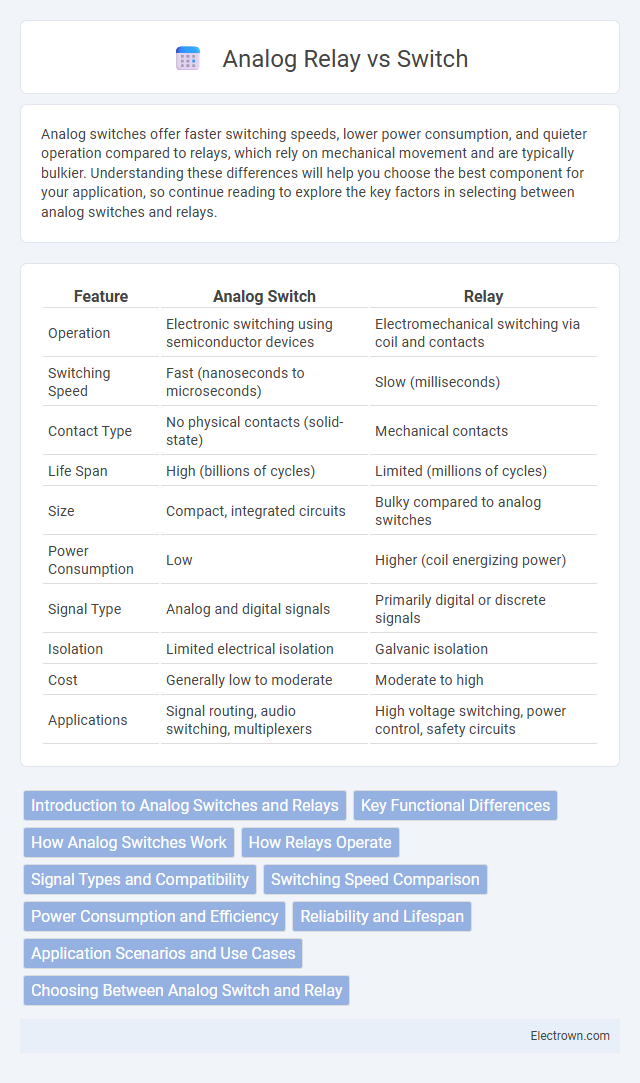Analog switches offer faster switching speeds, lower power consumption, and quieter operation compared to relays, which rely on mechanical movement and are typically bulkier. Understanding these differences will help you choose the best component for your application, so continue reading to explore the key factors in selecting between analog switches and relays.
Table of Comparison
| Feature | Analog Switch | Relay |
|---|---|---|
| Operation | Electronic switching using semiconductor devices | Electromechanical switching via coil and contacts |
| Switching Speed | Fast (nanoseconds to microseconds) | Slow (milliseconds) |
| Contact Type | No physical contacts (solid-state) | Mechanical contacts |
| Life Span | High (billions of cycles) | Limited (millions of cycles) |
| Size | Compact, integrated circuits | Bulky compared to analog switches |
| Power Consumption | Low | Higher (coil energizing power) |
| Signal Type | Analog and digital signals | Primarily digital or discrete signals |
| Isolation | Limited electrical isolation | Galvanic isolation |
| Cost | Generally low to moderate | Moderate to high |
| Applications | Signal routing, audio switching, multiplexers | High voltage switching, power control, safety circuits |
Introduction to Analog Switches and Relays
Analog switches are semiconductor devices that control signal paths in electronic circuits by opening or closing channels with low resistance, enabling efficient analog signal routing. Relays are electromechanical switches that use an electromagnetic coil to mechanically open or close contacts, providing galvanic isolation and handling high voltage and current loads. While analog switches offer faster switching speeds and lower power consumption, relays excel in high-voltage applications and provide superior isolation between control and output circuits.
Key Functional Differences
Analog switches provide faster and more precise control of signal paths using semiconductor technology, whereas relays rely on mechanical movement to open or close circuits, resulting in slower response times. Analog switches offer lower power consumption and longer operational lifespan due to the absence of moving parts, while relays handle higher voltage and current loads, making them suitable for switching heavy-duty signals. Understanding these key functional differences helps you choose the right component for applications requiring speed, durability, or high power handling.
How Analog Switches Work
Analog switches operate by using semiconductor devices such as MOSFETs to control the flow of analog signals, allowing or blocking current between input and output terminals. They provide low on-resistance and fast switching times, making them efficient for signal routing without mechanical wear. Unlike relays, analog switches do not rely on physical contacts, resulting in quieter operation and longer lifespan in electronic circuits.
How Relays Operate
Relays operate by using an electromagnetic coil to mechanically open or close electrical contacts, allowing control of high-voltage or high-current circuits with low-voltage signals. When current flows through the coil, it generates a magnetic field that moves the armature, switching the connected circuit on or off. You can rely on relays for robust isolation between control and load circuits, making them ideal in applications requiring physical separation and protection from high power.
Signal Types and Compatibility
Analog switches handle low-voltage, low-current signals with high precision, making them ideal for analog and digital signal paths, including audio, video, and sensor data. Relays, while capable of switching higher voltages and currents, are better suited for discrete on/off signals and can introduce mechanical noise and slower switching speeds. Understanding your signal type and compatibility needs ensures you select the right component for optimal performance in your circuit design.
Switching Speed Comparison
Analog switches offer significantly faster switching speeds, typically in the nanosecond to microsecond range, compared to relays which operate in milliseconds due to their mechanical nature. This rapid response makes analog switches ideal for high-frequency signal routing and precise timing applications. Your choice should consider that while relays provide galvanic isolation, their slower switching speed may limit performance in time-sensitive circuits.
Power Consumption and Efficiency
Analog switches consume significantly less power than relays, as they operate using semiconductor components without the need for coil energizing. Your system's efficiency improves with analog switches due to their low on-resistance and faster switching speeds, reducing energy loss during operation. Relays, while capable of handling higher voltages and currents, typically draw continuous power to maintain their state, leading to higher overall power consumption.
Reliability and Lifespan
Analog switches offer higher reliability and longer lifespan compared to relays due to their solid-state construction, which eliminates mechanical wear and contact degradation. Relays involve physical contacts that can suffer from oxidation, arcing, and mechanical fatigue, reducing their operational life especially under frequent switching conditions. Your choice of analog switch ensures consistent performance and durability in applications requiring high switching cycles and minimal maintenance.
Application Scenarios and Use Cases
Analog switches excel in low-voltage signal routing and audio switching applications due to their fast switching speeds, compact size, and low power consumption, making them ideal for telecommunications, instrumentation, and consumer electronics. Relays are preferred in high-voltage or high-current environments requiring galvanic isolation and robust switching, such as industrial automation, automotive systems, and power control circuits. The choice between analog switches and relays depends on factors like switching speed, load characteristics, isolation requirements, and durability in demanding conditions.
Choosing Between Analog Switch and Relay
Choosing between an analog switch and a relay depends on factors such as switching speed, power consumption, and signal integrity. Analog switches provide faster switching speeds, lower power consumption, and smaller size, ideal for low voltage and high-frequency applications. Relays excel in handling higher voltages and currents with galvanic isolation, making them suitable for power switching and applications requiring physical separation between control and load circuits.
Analog Switch vs Relay Infographic

 electrown.com
electrown.com